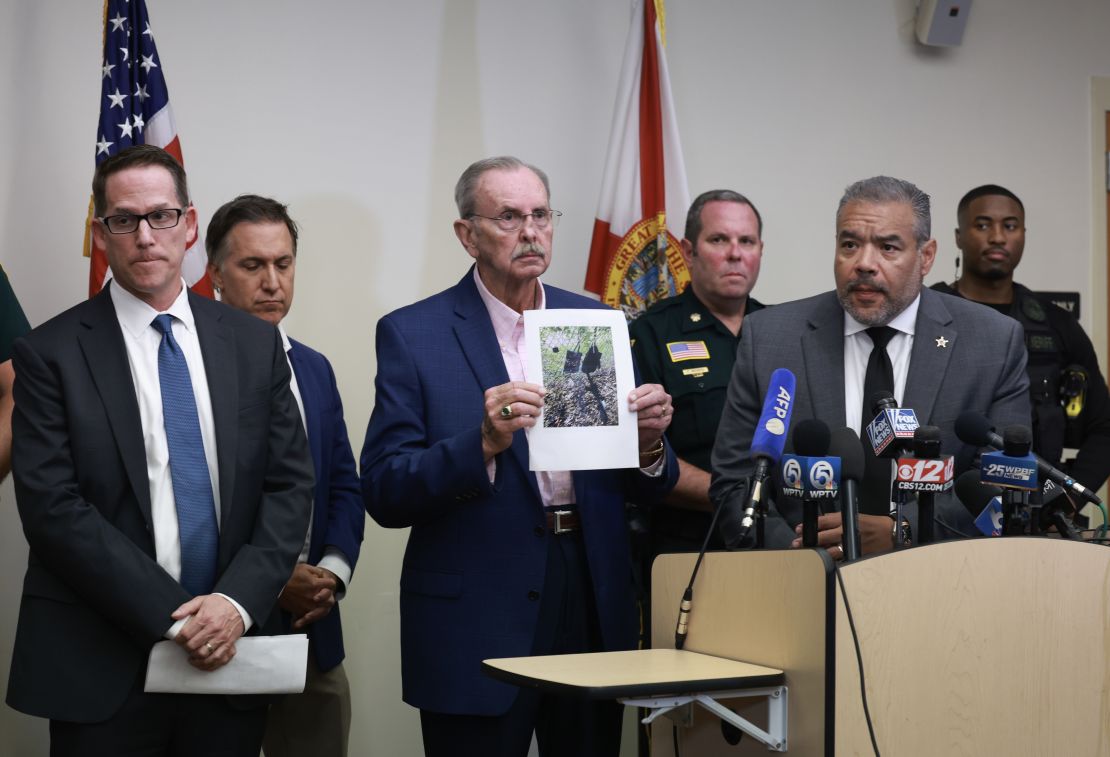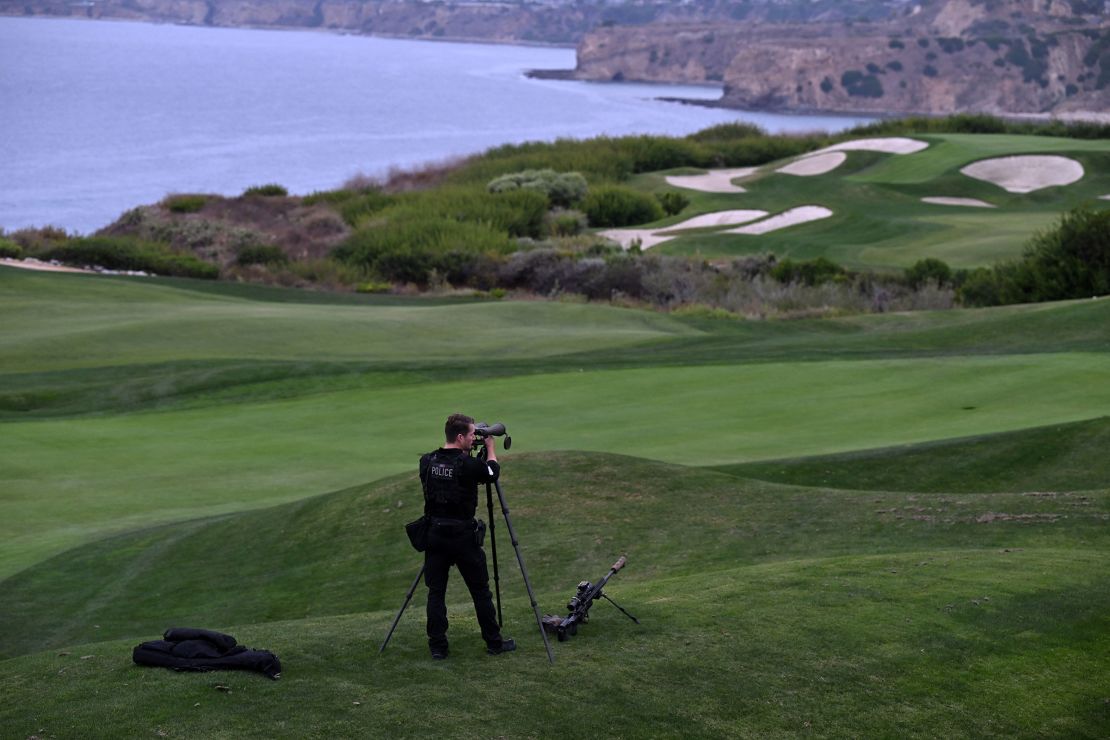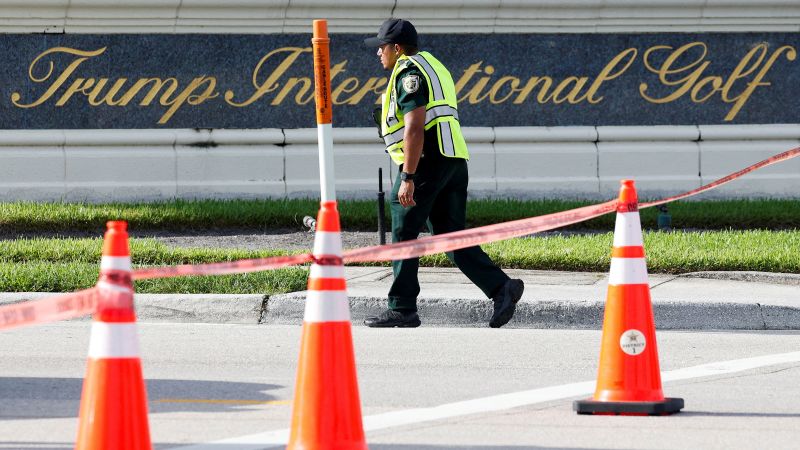The second apparent assassination attempt against Donald Trump in as many months is raising new alarms about whether the Secret Service can adequately protect the former president or whether more needs to be done to bolster the security of the Republican presidential candidate even though he’s not in office.
While Secret Service agents on Sunday prevented the potential shooter from firing at Trump while golfing at his West Palm Beach course – unlike the would-be assassin in Butler, Pennsylvania – questions are again swirling about how another gunman was able to get within several hundred yards of the former president, especially given the outing was not a publicly announced event.
“He’s a former president running for reelection again. We have to be able to keep him safe,” Rep. Jared Moskowitz, a Florida Democrat and member of the congressional task force now investigating both assassination attempts, told CNN’s Anderson Cooper on Sunday. “This is getting embarrassing for the agency, and people in Congress are bewildered why we’re in this situation now for a second time.”
While a sitting president is always afforded a different level of protection than candidates seeking the same office, a variety of credible threats against Trump and the first unsuccessful assassination attempt prompted the Secret Service to provide him with additional resources not usually offered to someone in his position.
But after a second close call, even President Joe Biden recognized a problem still persists.
“The Secret Service needs more help,” Biden told reporters while leaving the White House on Monday.
Acting US Secret Service Director Ronald Rowe is expected to meet with Trump and local law enforcement on Monday, two sources familiar with the matter told CNN.
In July, the Secret Service’s failures were quickly apparent from Trump’s Butler rally, when a gunman was able to climb onto a roof 150 yards from the stage and fire eight shots at Trump, who was struck in the ear. Secret Service Director Kimberly Cheatle resigned in the fallout from the assassination attempt, leading to Rowe’s appointment as acting director.
On Sunday, the Secret Service spotted the gunman before he could fire his SKS-style weapon, after an advance a team traveling ahead of the former president at the Trump International Golf Club saw the rifle barrel through the course’s fence. Agents fired at the gunman, who was about 300 to 500 yards away from Trump, and he fled in a black Nissan before being apprehended.
Success in preventing the would-be gunman from firing any shots is being overshadowed by renewed questions about whether the Secret Service lacks the manpower, funding or operational flexibility to consistently protect the former president, particularly in similar outdoor settings, even as the agency’s budget has increased in the past decade.
Those concerns were underscored by details revealed Monday about the suspected shooter’s whereabouts before he was ultimately spotted by Secret Service agents.
Ryan Wesley Routh, the suspect in the apparent assassination attempt, may have spent nearly 12 hours on Sunday near the area where he was spotted along the perimeter of the Trump International Golf Club, based on his cell-phone data, according to charging documents unsealed on Monday.

“The service needs to move away from thinking about Trump as a former president and start understanding the threat environment,” said Jonathan Wackrow, a CNN law enforcement analyst and former Secret Service special agent, citing both the domestic security challenges and the Iranian plot to try to assassinate Trump.
“The intelligence community knows this is a credible threat,” he added, referring to Iran. “That alone means the perimeter needs to be pushed out further.”
The agency’s sprawling protective missions will be tested again later this month, when world leaders descend on New York City for the annual meetings of the United Nations General Assembly. The Secret Service assumes security responsibility for all visiting foreign dignitaries, placing additional strain on its resources at the same time it is working to protect a former president along with the sitting vice president and president as they all hit the campaign trail.
Trump’s Sunday golf round was a last-minute add to his calendar, according to sources familiar with the matter, meaning the Secret Service would not have had much time to secure the perimeter. And while the golf outing was not disclosed publicly, Trump is also a creature of habit and frequently golfs at the course while staying at Mar-a-Lago.
Palm Beach County Sheriff Ric Bradshaw said at a Sunday news conference that the security protection levels for Trump are not the same as for sitting presidents.
“The level where he is at right now, he is not the sitting president. If he was, we would have had the entire golf course surrounded. But because he’s not, security is limited to the areas the Secret Service deems possible,” Bradshaw said. “I would imagine the next time he comes to the golf course, there would probably be a little more people around the perimeter.”

When the president travels, the Secret Service leans on other agencies in the federal government, such as the White House Communications Agency and the Department of Defense, to bolster cell coverage and provide bulletproof glass and other infrastructure. These security measures were not extended to presidential candidates and largely not needed for former presidents who aren’t holding large campaign-style events after leaving office.
Since the July 13 shooting in Butler, the Secret Service has added its own mobile communications apparatus to create a private cellular network for Trump’s detail, both at his campaign events and to his motorcade, a federal source familiar with the planning told CNN. The agency also is surrounding Trump with ballistic glass at outdoor rallies and has increased the number of agents on his detail.
“What you’re seeing is actually the protective structure moving closer to the vice-presidential level, which is a significant enhancement from what the protective model typically is for former presidents, such as former President Obama or Bush or Clinton,” Wackrow said.
At a Senate hearing on the Butler assassination attempt in July, Rowe said the Secret Service had provided additional resources at the former president’s Mar-a-Lago residence, including investments of $4 million since Trump left office.
Securing golf courses for presidents has long posed a unique challenge, including at Trump’s properties in particular, according to people familiar with the matter.
Like other presidents before him, Trump’s presence at a golf course does not prompt the club to shut down to the general public, nor for the roads to be closed nearby. Instead, agents in golf clothes typically ride in golf carts ahead and behind the president as he plays and secure the areas in the minutes before the president arrives.
“Today, the model worked, where those agents that were flanking in advance of the president, their role specifically is to identify this type of specific long-range threat,” Wackrow said. “Now the question … is how is this shooter able to get to that outer perimeter, an area that, you know, should have been identified as a vulnerability previously?”
Cheryl Tyler, a retired Secret Service special agent, told CNN’s Wolf Blitzer on Monday that golf courses are challenging because the topography of the land can vary widely, along with factors such as other golfers on the course.
“They’re all challenging,” Tyler said. “That being said, that protectee has the right to go play golf, swim, ski, do any sport activity. It is challenging for the Secret Service because we have to figure out the best way to make sure the protectee stays safe at all times. There’s no one-stop solution for that.”
One potential unknown is how Trump would react to additional security measures, both at rallies and during visits to the golf course or his various clubs, which could restrict certain movements or impact the lifestyle he’s led since leaving the White House.

At times, the Trump campaign has disagreed with the Secret Service over proposals intended to mitigate security concerns at his rallies, according to a source familiar with the interactions. Some solutions offered by the agency, such as having trucks lined up as a visual impediment, have been rejected by campaign officials because they didn’t like how it would look visually, according to the source.
At the same time, Trump officials have pushed back on any suggestion that the campaign is in charge of security – placing that responsibility firmly at the feet of Secret Service.
Moskowitz said Sunday that the Secret Service needed to consider taking more drastic measures, such as shutting down a significantly wider perimeter.
“The Secret Service needs to start telling us whether or not they can actually keep someone safe in these circumstances unless they’re shutting down whole areas,” Moskowitz said. “And if that’s what we have to do, that’s what we have to do.”
Top government officials, including Biden, are pointing to a lack of resources at the Secret Service in the fallout from the second assassination attempt.
“The Secret Service must come to Congress tomorrow, tell us what resources are needed to expand the protective perimeter, & lets allocate it in a bipartisan vote the same day,” Rep. Ro Khanna, a California Democrat, posted on X on Sunday.
However, the agency has already seen its funding expand dramatically over the past decade, including a 9% increase just this year to nearly $3.1 billion.
In the “protective operations” category, used for security operations around “principals” such as the president, vice president and former presidents, the agency’s funding jumped 23% this year to $1.5 billion.
It’s typical for the agency to be allocated more money during a year with a presidential election, and the 2024 funding far exceeds figures from 2016 and 2020.
The levels set by Congress in its most recent funding bill exceed those requested by Biden in his yearly budget request. In his 2025 budget request submitted to Congress in May, the president proposed a reduction in overall funding for the Secret Service, to $2.9 billion. That includes a 14% cut to protective operations. Such a reduction would not necessarily be unusual for a non-election year, nor is the proposed budget binding on Congress.
Asked at the July Senate hearing whether the Secret Service needed more money, Rowe said every agency in the executive branch “would take more resources.”
The agency’s increase in funding over the past decade has not closed its staffing shortages, even as officials have said they are working urgently to hire more personnel.
Instead, issues of culture could be at the root of the Secret Service’s staffing shortfalls. A survey of the best places to work in the federal government ranked the agency at No. 413, near the bottom of a list of 459 subcomponent agencies.
CNN’s Holmes Lybrand, Kristen Holmes and Whitney Wild contributed to this report.
Read the full article here



